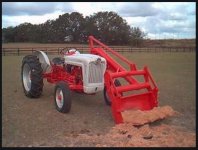rScotty
Super Member
- Joined
- Apr 21, 2001
- Messages
- 9,658
- Location
- Rural mountains - Colorado
- Tractor
- Kubota M59, JD530, JD310SG. Restoring Yanmar YM165D
I have a great little 1910 that lacked a loader when I bought it. I found a loader from a machine (also a 1910) at Weaver's and am having trouble figuring out the plumbing.
The 1-arm loader valve (also a Ford made by Diesel kiki) has the two hoses that go to the diverter block, plus a port that is marked "T", which I assume means back to the tank. There is only one place for the hard pipe that goes from this port to go, which is atop the transmission case. Most pictures of the 1910 with this loader show the pipe connecting on the starboard side, just aft of the split point.
I checked the machined surface of the transmission for signs that there was a knock-out plug, but found none. It can't be that every 1910 that wanted a loader required a dealer to drill and tap a special hole for the hard pipe from the T port of the loader valve, right? The hard pipe has a drilled bolt and two o-rings (top and bottom) in it. My 1910 is a 1984 model (2266).
What am I missing? Really want to install this loader, but need help to do it right.
Thanks in advance,
jim
Jim, lets back up a little bit. I read your original post as saying that you had found one of the vintage Ford 1-arm Loaders (model 711 or 722 probably) and want to adapt that loader to your Ford 1910. I didn't know that was possible to adapt a loader for the Ford 601 to the Ford 1910.... their frames are very different. Although anything can be done. So I guess you could do that. Keep in mind that those old loaders had a gravity drop bucket rather than a hydraulically-controlled bucket. So their loader control valve is different.
Take a look at:
https://www.tractorbynet.com/forums/buying-pricing-comparisons/58890-ford-601-series-2.html
Frankly I'd prefer to go with a more modern type of loader. Those old ones were mainly for cleaning stalls & feeding hay.
But that's why I was asking for some more photos. So we could see just what you have.
rScotty
